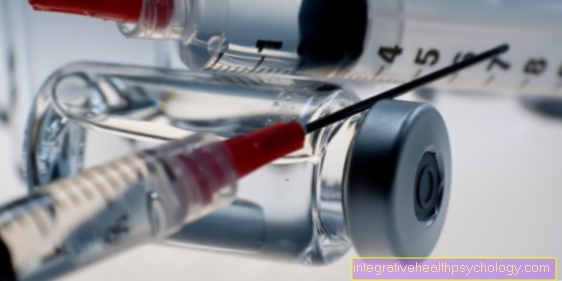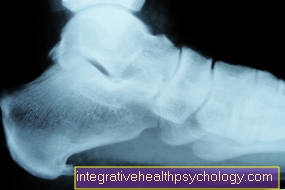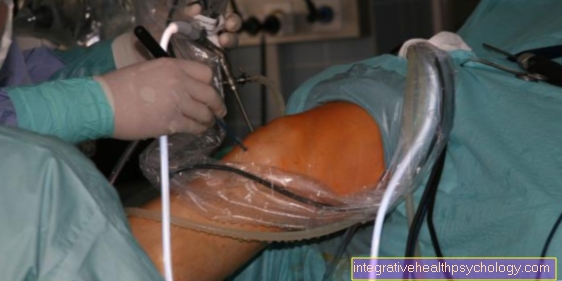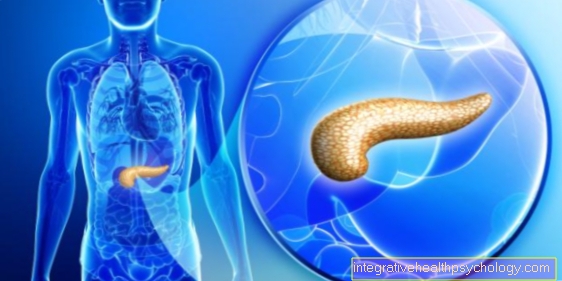Causes of atherosclerosis
introduction
Arteriosclerosis (vascular calcification / arterial calcification) is an injury to the inner layer of the arterial wall. As a result of the injury, the vessel narrows due to the so-called plaque that forms at the site of the vascular injury.
This can arise for various reasons; with high blood pressure, stress and sedentary lifestyle, and poor diet increasing the susceptibility of the arteries to such vascular damage.

The most common causes of arteriosclerosis are:
- high blood pressure
- Obesity
- stress
- Smoke
- Diabetes mellitus
- Hyperthyroidism
- increased LDL cholesterol
- decreased HDL cholesterol
- gout
- Rheumatoid arthritis
- chronic kidney failure
Find out more about the topic here: Risk factors of arteriosclerosis
High blood pressure as a cause of arteriosclerosis
High blood pressure promotes the development of arteriosclerosis. Usually the walls of the blood vessels are elastic and soft. However, due to the permanently increased blood pressure, the blood vessels lose this property, especially the innermost wall layer becomes brittle.
Small injuries occur again and again, an inflammatory reaction often develops in these areas and a wide variety of cells are deposited. This is the beginning of arteriosclerosis. The deposits in the blood vessels constrict the blood vessel and the heart needs more pressure to pump the blood through the constricted vessel.
Read on below: Lower blood pressure
Atherosclerosis due to obesity
In addition to high blood pressure, obesity is also an important risk factor for the development of arteriosclerosis, although obesity is now viewed more differently.
Above all, belly fat (also in medical terminology visceral fat called) leads to the development of hardening of the arteries. Since, with belly fat, inflammatory messengers are also preferably present in the blood.
Most overweight people also suffer from high blood lipid levels. The excess cholesterol molecules are then deposited in the wall of the blood vessels and promote arteriosclerosis.
Find out more at: These are the consequences of being overweight
Does chronic stress lead to arteriosclerosis?
Long-term stress can also lead to the development of arteriosclerosis.
- For one thing, stress leads to increased blood pressure. This leads to the elastic walls of the blood vessels quickly becoming brittle.
- When the body is under stress, not only does blood pressure rise, but certain stress hormones are also released in the adrenal glands. These are adrenaline and cortisol.
- Both promote inflammatory processes, which we now know are the beginning of hardening of the arteries.
- This is because more blood lipids are deposited in the damaged vascular wall.
Read on below: How can you reduce stress?
Smoking as a cause of atherosclerosis
Smoking is clearly a risk factor for arteriosclerosis. However, it depends on how much and how long you have smoked.
Nicotine consumption harms the body in many ways:
- On the one hand, it favors the release of adrenaline and
- makes the blood pressure rise.
- On the other hand, the blood becomes thicker due to the lack of oxygen, as more red blood cells are formed.
- The blood platelets (thrombocytes) also tend to stick together more easily and thromboses (blood clots) can develop.
- Free radicals from smoking can also damage the inner walls of the blood vessels.
It is therefore worth stopping cigarette consumption.
Find out more at.
- Circulatory disorders caused by smoking
- How to quit smoking
- Illnesses related to smoking
Diabetes mellitus as a trigger for arteriosclerosis
Diabetics have a very high risk of hardening of the arteries. On the one hand, this is due to the fact that there are usually other risk factors such as
- increased blood pressure,
- Obesity and
- increased blood lipid levels.
One then speaks of metabolic syndrome.
Diabetes mainly damages the small blood vessels (microangiopathy). This leads to diseases of the kidneys, eyes and nerves. Heart attacks (arteriosclerosis of the large blood vessels) are also much more common in diabetics. This is due to the fact that the constant high level of sugar usually massively worsens the existing lipid metabolism disorder.
Read more about this: Consequences of diabetes
Can an overactive thyroid trigger atherosclerosis?
An overactive thyroid is not a classic risk factor for arteriosclerosis.
However, thyroid hormones affect the entire metabolism of the body and an overactive condition can have far-reaching consequences. Most patients suffer from restlessness, palpitations, diarrhea, increased sweating and unwanted weight loss.
Because the metabolism is so uncontrolled, there is also an increased breakdown of fat molecules and the cholesterol level is increased. However, this favors the deposition of cholesterol particles in the vessel walls and ultimately promotes arteriosclerosis secondarily.
Learn more at: Hyperthyroidism
Atherosclerosis due to high cholesterol
A permanently high cholesterol level is a risk factor for the development of arteriosclerosis, this is clearly scientifically proven.
It used to be thought that cholesterol was deposited in the walls of blood vessels like lime in a pipe.
Today, however, we know that small inflammation foci or damage to the vessel wall are necessary to cause arteriosclerosis.
As part of these processes, cholesterol is then increasingly deposited in the vessel wall and ultimately forms plaque.
also read: Diet for high cholesterol levels
How Can Diet Contribute to Atherosclerosis?
An improper diet (especially foods containing sugar and fat) can also lead to arteriosclerosis.
On the one hand, a poor diet and a lack of exercise are responsible for being overweight. And being overweight leads to high blood pressure and diabetes mellitus.
In addition, the patients suffer from significantly increased cholesterol levels. This constellation, which is called the metabolic syndrome, is responsible for the development of arteriosclerosis.
In order to avoid obesity and all its complications, a wholesome Mediterranean diet is recommended, especially high-fat foods should be avoided. Lots of vegetables, whole grains, fish and lean meat should be main components of the diet.
In addition, the development of arteriosclerosis is favored by the fact that a high-fat and high-cholesterol diet increases the blood lipids in the blood to such an extent that they penetrate through the crack into the inner wall of the vessels, settle there and thicken, which further narrows the vessel lumen.
The blood components that settle on the inside of the vessel, also known as plaque or atheroma, can also peel off, be carried away by the bloodstream and cause dangerous occlusion of an artery.
Learn more at:
- Metabolic syndrome
- Diet for high blood lipid levels
Atherosclerosis due to a sedentary lifestyle
It is not just diet that plays a major role in the development of arteriosclerosis.
Lack of exercise is also a significant risk factor, as little physical activity leads to obesity. On the other hand, one could achieve an insulin-dependent sugar absorption in the muscles through exercise, which would counteract existing diabetes mellitus.
Exercise is therefore immensely important in order to avoid civilization diseases such as high blood pressure, diabetes and obesity. Even after a heart attack, it is recommended to go back to exercise in special cardiac exercise groups or under medical supervision.
That might be interesting for you too: High blood pressure and exercise
Atherosclerosis due to hereditary predisposition (familial accumulation)
There are also genetic factors that contribute to the development of atherosclerosis. There are always families in which heart attacks and strokes occur more frequently.
The triggering genes are not already known in every case. Researchers keep discovering genes in the laboratory that can promote arteriosclerosis. Often it is changes in the genetic material that favor small inflammatory processes in the blood vessel wall or a mutation in lipid metabolism that leads to a significantly increased cholesterol level.
Atherosclerosis then starts very early. With increasing age, the vessels are then narrowed further and may then lead to the complications described. The first affected vessel is usually the main artery. The abdominal organs, the arteries supplying the heart and the brain are often most severely affected.
The peripheral vascular branches that supply the arms and legs (extremities) can be severely affected by arteriosclerosis. The arteriosclerosis caused by fatty deposits between the intima and media affects not only the vessels of the abdominal organs but also the kidneys, adrenal glands, spleen and pancreas (pancreas).
Atherosclerosis due to gout
Gout is caused by the accumulation of uric acid crystals in joints. The cause is an increased uric acid level in the blood. This is called hyperuricemia in technical terms.
This can also lead to arteriosclerosis or accelerate arteriosclerotic changes in the blood vessel walls. This can be enhanced by high-fat foods or alcohol consumption. Genetic factors also play a role.
One should therefore always treat elevated uric acid levels with medication.
Find out more at: Proper nutrition for gout
Atherosclerosis in Mönckeberg's sclerosis
The so-called focal calcification or Mönckeberg sclerosis is a special form of vascular greasing.
In patients over 50 years of age, fat is deposited in the media (middle layer of the arterial wall). Furthermore, there is a degeneration of the smooth muscle cells.
The age-related vascular changes must still be separated from the pathological arteriosclerosis. This leads to calcification of the media due to the destruction of the smooth vascular muscle cells. There is a loss of elasticity of the vessels, wall thickening and thus lumen narrowing. The vessels become rigid and there is a corresponding change in blood pressure and the flow properties of the blood. In extreme cases, the so-called goosegurgel artery occurs, in which the vessels are ossified due to excessive calcification.
How does arteriosclerosis develop?
The body regards the tear in the inner wall of the arteries as the quickest point to be sealed. For this reason, platelets adhere to them (natural sealing process for open vessels). Collagen, fat-rich substances and so-called proteoglycans also attach to the tear site.
All of the substances cause the site to close at the tear. However, the end is by no means smooth and thus does not correspond to the natural inner layer of the arteries, which the blood glides past without turbulence. The newly created, rough, sealed area causes the blood stream flowing past to be swirled and slowed down, and blood platelets and tiny blood components continue to be deposited on them.
A growing plaque forms. This leads to the fact that the diameter of the artery continues to narrow and the elasticity of the arterial wall decreases. The artery scleroses ("calcified") and less blood can flow past this point.
As a result, there is an insufficient supply of the adjoining organs until the vessel closes completely (thrombosis). If this affects the coronary arteries, a heart attack occurs.
Find out more at:
- thrombosis
- Heart attack
Recommendations from the editorial team
- arteriosclerosis
- Atherosclerosis symptoms
- Atherosclerosis Therapy
- Atherosclerosis prevention
- Can you treat arteriosclerosis?



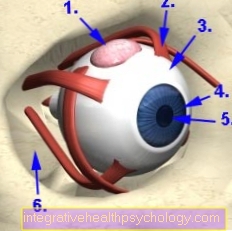




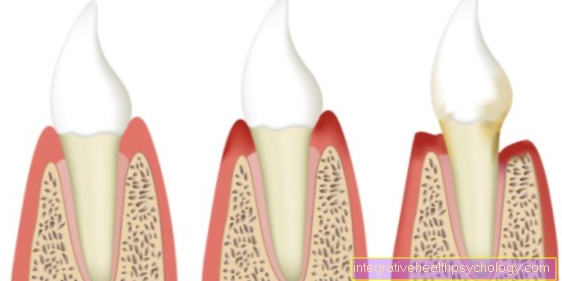


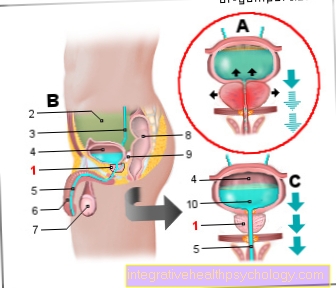






.jpg)


